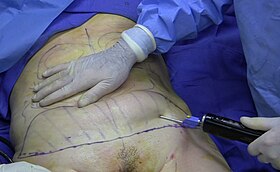
Back مص الشحم Arabic Liposucció Catalan Liposukce Czech Fettabsaugung German Liposukcio Esperanto Liposucción Spanish Rasvaimu Estonian چربیکشی Persian Rasvaimu Finnish Liposuccion French
| Liposuction | |
|---|---|
 A plastic surgeon performing liposuction surgery | |
| Other names | Lipoplasty, lipectomy, fat modeling, liposculpture, suction lipectomy, suction-assisted fat removal, lipo, lymph-sparing liposuction, tumescent liposuction, water-assisted liposuction, power-assisted liposuction, laser-assisted liposuction, ultra-sound assisted liposuction |
| ICD-10-PCS | 0JDL3ZZ: RT UPPER LEG; 0JDM3ZZ: LT UPPER LEG; OJDN3ZZ: RT LOWER LEG; 0JDP3ZZ: LT LOWER LEG |
| MeSH | DO65134 |
| MedlinePlus | 002985 |
| Part of a series on |
| Human body weight |
|---|
Liposuction, or simply lipo, is a type of fat-removal procedure used in plastic surgery.[1] Evidence does not support an effect on weight beyond a couple of months and does not appear to affect obesity-related problems.[2][3] In the United States, liposuction is the most common cosmetic surgery.[4][5]
The procedure may be performed under general, regional, or local anesthesia. It involves using a cannula and negative pressure to suck out fat.[4] As a cosmetic procedure it is believed to work best on people with a normal weight and good skin elasticity.[4]
While the suctioned fat cells are permanently gone, after a few months overall body fat generally returns to the same level as before treatment.[2] This is despite maintaining the previous diet and exercise regimen. While the fat returns somewhat to the treated area, most of the increased fat occurs in the abdominal area. Visceral fat—the fat surrounding the internal organs—increases, and this condition has been linked to life-shortening diseases such as diabetes, stroke, and heart attack.[2]
- ^ Dixit, VV; Wagh, MS (May 2013). "Unfavourable outcomes of liposuction and their management". Indian Journal of Plastic Surgery. 46 (2): 377–92. doi:10.4103/0970-0358.118617. PMC 3901919. PMID 24501474.
- ^ a b c Seretis, Konstantinos; Goulis, Dimitrios G; Koliakos, Georgios; Demiri, Efterpi (2015). "Short- and Long-Term Effects of Abdominal Lipectomy on Weight and Fat Mass in Females: A Systematic Review". Obesity Surgery. 25 (10): 1950–8. doi:10.1007/s11695-015-1797-1. PMID 26210190. S2CID 37230028.
- ^ Seretis, K; Goulis, DG; Koliakos, G; Demiri, E (December 2015). "The effects of abdominal lipectomy in metabolic syndrome components and insulin sensitivity in females: A systematic review and meta-analysis". Metabolism: Clinical and Experimental. 64 (12): 1640–9. doi:10.1016/j.metabol.2015.09.015. PMID 26475176.
- ^ a b c Norton, Jeffrey A. (2012). Surgery Basic Science and Clinical Evidence. Berlin, Heidelberg: Springer Berlin Heidelberg. p. 2014. ISBN 9783642572821.
- ^ Khan, MH (November 2012). "Update on liposuction: clinical pearls". Cutis. 90 (5): 259–65. PMID 23270199.